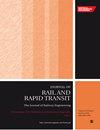混合动力总成结构中铁路能耗最小化的优化算法:使用新型二维效率图近似的直接方法
IF 2.1
4区 工程技术
Q3 ENGINEERING, CIVIL
Proceedings of the Institution of Mechanical Engineers Part F-Journal of Rail and Rapid Transit
Pub Date : 2024-06-22
DOI:10.1177/09544097241237836
引用次数: 0
摘要
SEnSOR(Smart Energy Speed Optimizer Rail)是德国航天中心开发的一种基于直接法的优化算法,用于确定铁路车辆的最小能量速度轨迹。本文旨在减少模型误差并改进该算法,以适用于任何替代动力总成结构。简化模型(如将不同列车部件的效率图投射到一维空间)可能会导致不准确和非最佳实际情况。在这项工作中,使用了二维剖面 Chua 函数表示法来捕捉效率图的完整行为并讨论其优点。为此,开发了一种新的平滑方法。据观察,当一维和二维模型相互比较时,能量计算平均存在 6% 的误差。以前,求解不同的动力总成结构需要手动修改优化问题,非常耗时。采用模块化方法对算法进行了修改,使其能够灵活调整问题的表述,从而在用户输入最少的情况下自动考虑动力总成结构的任何变化。通过对欧盟项目 FCH2RAIL 开发的具有三种不同动力源的双模式列车进行优化,证明了该算法的优势。先进的算法现在能够适应如此复杂的结构,并在合理的时间内提供可行的优化结果。本文章由计算机程序翻译,如有差异,请以英文原文为准。
Optimization algorithm for minimizing railway energy consumption in hybrid powertrain architectures: A direct method approach using a novel two-dimensional efficiency map approximation
SEnSOR (Smart Energy Speed Optimizer Rail) is a direct method based optimization algorithm developed at DLR for determining minimum energy speed trajectories for railway vehicles. This paper aims to reduce model error and improve this algorithm for any alternative powertrain architecture. Model simplifications such as projecting the efficiency maps of different train components onto one-dimensional space can lead to inaccuracies and non-optimalities in reality. In this work, 2D section-wise Chua functional representation was used to capture the complete behavior of efficiency maps and discuss its benefits. For this purpose, a new smoothing method was developed. It was observed that there is an average of 6% error in the energy calculation when both, 1D and 2D, models are compared against each other. Previously, solving for different powertrain architectures was time consuming with the requirement of manual modifications to the optimization problem. With a modular approach, the algorithm was modified to flexibly adapt the problem formulation to automatically take into account any changes in powertrain architectures with minimum user input. The benefit is demonstrated by performing optimization on a bi-mode train with three different power sources as developed within the EU-project FCH2RAIL. The advanced algorithm is now capable to adapt to such complex architectures and provide feasible optimization results within a reasonable time.
求助全文
通过发布文献求助,成功后即可免费获取论文全文。
去求助
来源期刊

CiteScore
4.80
自引率
10.00%
发文量
91
审稿时长
7 months
期刊介绍:
The Journal of Rail and Rapid Transit is devoted to engineering in its widest interpretation applicable to rail and rapid transit. The Journal aims to promote sharing of technical knowledge, ideas and experience between engineers and researchers working in the railway field.
 求助内容:
求助内容: 应助结果提醒方式:
应助结果提醒方式:


